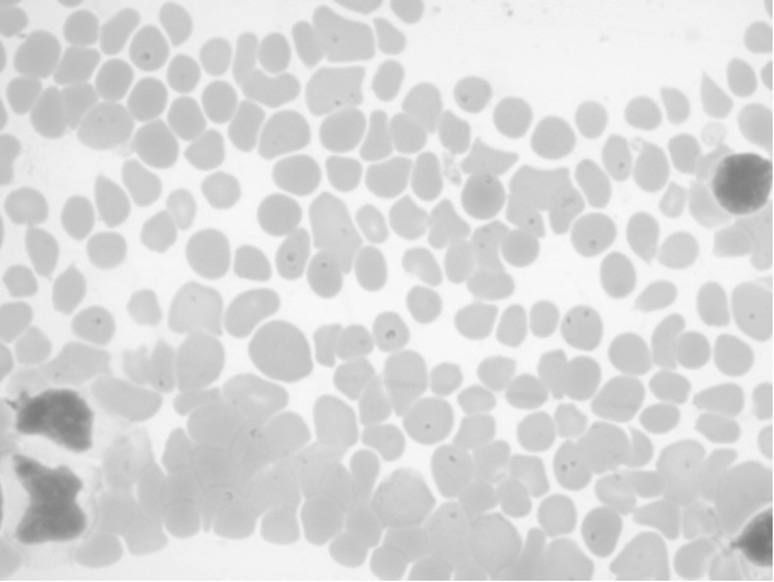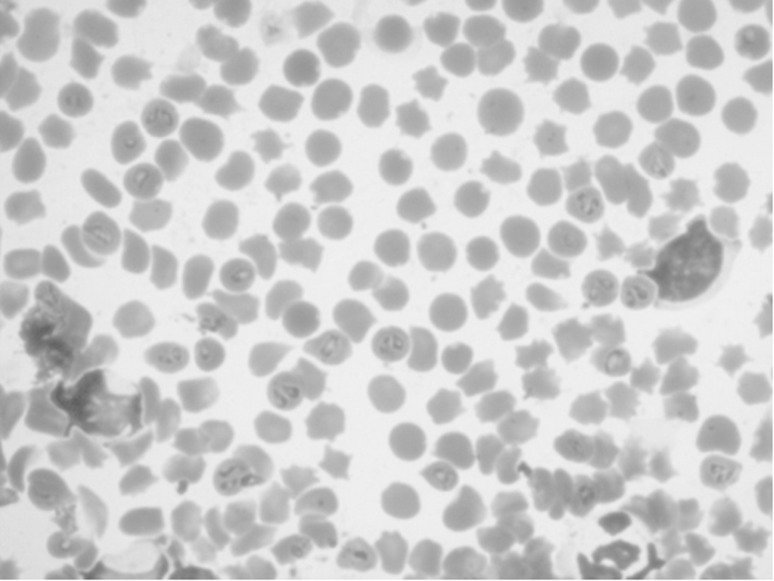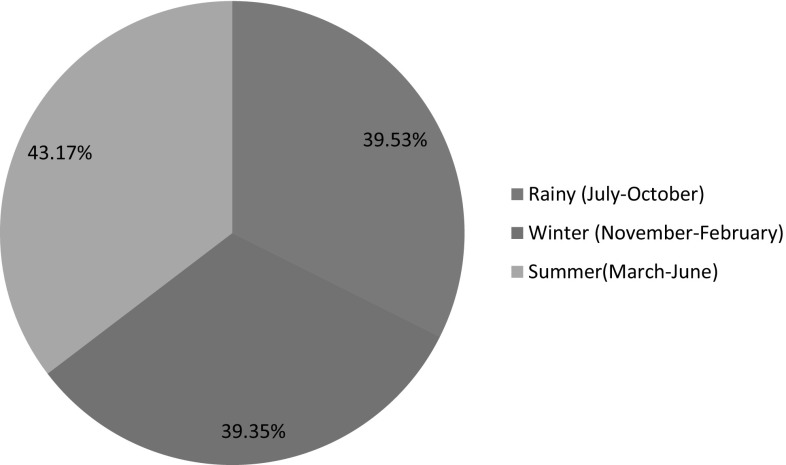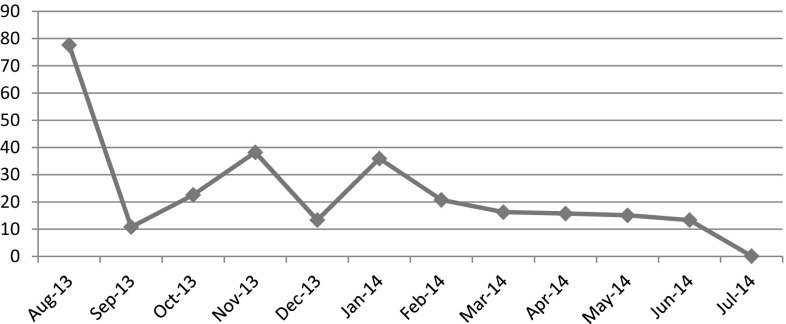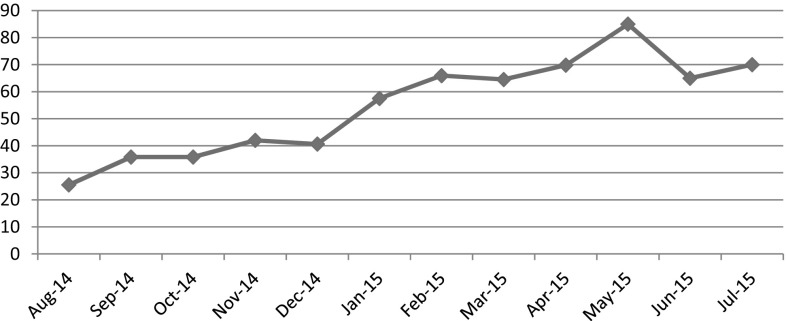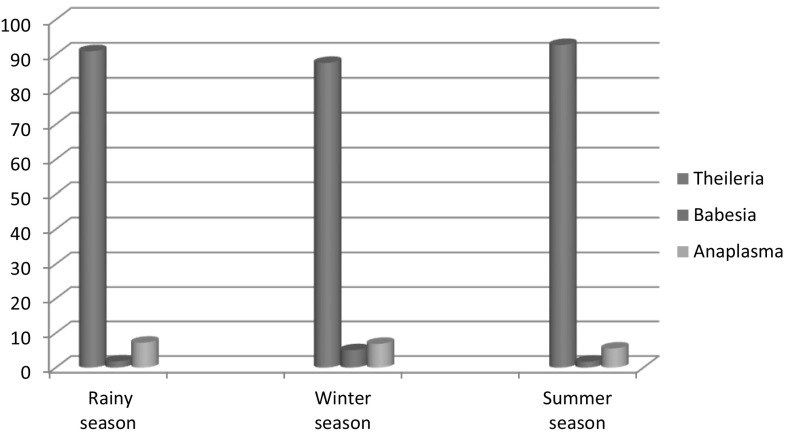Abstract
The present study report the seasonal prevalence of blood parasitic diseases in cross bred cattle in Mysore and its surrounding districts of Karnataka such as Mandya, Chamaraj Nagar and Kodagu. The study was undertaken for a period of 2 years from August 2013 to July 2015. A total of 1655 blood samples were collected from clinically suspected cattle for blood parasitic diseases with clinical symptoms of anorexia, high fever, anaemia, salivation, enlargement of superficial lymphnodes, haemoglobinuria and sudden drop in milk yield. The blood samples were examined by giemsa’s staining technique. Of the 1655 blood samples screened, 673 (40.22%) blood samples were found positive for blood parasites. Amid 673 positive samples, 609 (90.49%), 19 (2.82%) and 45 (6.68%) were found positive for Theileria annulata, Babesia bigemina and Anaplasma marginale respectively. The season wise prevalence revealed that, the highest prevalence was observed in summer months (March–June) (43.17%) followed by rainy (July–October) (39.53%) and winter season (November–February) (39.35%). Further, the month wise prevalence showed highest in August (77.64%) (Rainy month) followed by November (38.23%) and January (35.93%). During August-2013 to July 2014 and between August-2014 and July 2015, the highest was found in the month of May (85%) followed by July (70%) and April (69.81%). Theileriosis was most prevalent in summer (92.73%) followed by rainy (90.95%) and winter season (87.61%). Babesiosis was most prevalent in winter season (5.04%) followed by rainy (1.8%) and summer season (1.7%) whereas, Anaplasmosis was most prevalent in rainy season (7.23%) followed by winter (6.88%) and summer season (5.55%) during two years of study period.
Keywords: Seasonal prevalence, Blood parasites, Blood smear, Crossbred cattle, Mysore
Introduction
The blood parasitic diseases mainly Theileriosis, Babesiosis, Anaplasmosis and Trypanosomiasis were major problem in dairy industry. It is known that, most of the blood protozoa and rickettsial diseases are transmitted by ticks. It is of great economic importance in Asia and has always been jeopardising obstacle for cross bred cattle dairy industry. The crossbred cattle are more susceptible to blood parasitic disease compared to indigenous or pure exotic breeds (Farhan et al. 2012). If correct control strategies were not implemented, the blood parasitic diseases have grave impact on cattle health, milk yield, draft and meat production, which in turn affects overall cattle production, hence lowering agricultural and socio economic development in India. Devendra (1995) reported the annual loss of US $800 million due to tropical Theileriosis in India.
The hot and humid climate is highly conducive and favours the multiplication and survivability of Ticks (Kohli et al. 2014). The prevalence of blood parasitic disease was reported by many workers viz., Ananda et al. (2009); Krishna Murthy et al. (2016) from Karnataka, Kohli et al. (2014) from UttarKand, Vahora et al. (2012) from Gujarat and Nair et al. (2011) from Kerala in cattle and buffaloes in India. The crux of the present study was to report the seasonal prevalence of various blood parasitic diseases in Mysore and its surrounding districts of Karnataka state such as Mandya, Chamaraj Nagar and Kodagu.
Materials and methods
Collection of blood samples
In the present study, a total of 1655 blood samples from cross bred cattle were collected with Ethylene diamine tetra acetate (EDTA) which are presented to Primary Veterinary Centres, Veterinary Dispensaries and Veterinary Hospitals of Mysore and surrounding districts like Mandya, Chamaraj Nagar and Kodagu. The blood samples were collected from clinically suspected animals for blood parasitic diseases with a manifestation of anorexia, high fever, anaemia, salivation, enlargement of superficial lymphndes, haemoglobinuria and sudden drop in milk yield. The blood samples were collected for 2 years from August 2013 to July 2015 and were analysed for presence of blood parasites. The collected blood samples were immediately brought to the laboratory for examination.
Staining of blood smears and identification
The thin blood smears were made and stained with Giemsa’s stain (Benjamin 2005) and examined under microscope with oil immersion (100X). The blood parasites were identified based on the morphological character as described by Soulsby (1982).
Results and discussion
In the present study, the seasonal prevalence of blood parasitic diseases was recorded in cross bred cattle of Mysore and its surrounding districts such as Mandya, Chamaraj Nagar and Kodagu. Among 1655 blood samples examined, 673 (40.22%) were found positive for various blood parasites. Amid 673 positive samples, 609 (90.49%), 19 (2.82%) and 45 (6.68%) blood samples (Table 1) were positive for Theileria annulata (Fig. 1), Babesia bigemina (Fig. 2) and Anaplasma marginale (Fig. 3) respectively. The overall prevalence of blood parasitic disease in the present study (40.22%), was almost closer to earlier reports by Ananda et al. (2009) (43.18%) and Krishna Murthy et al. (2016) (43.3%), who reported from Bangalore and Shimoga regions of Karnataka respectively. Among blood parasitic diseases in the present study, the highest prevalence was observed with Theileriosis (90.49%) followed by Anaplasmosis (6.68%) and Babesiosis (2.82%). Similar observations were made by Krishna Murthy et al. 2016 who reported highest prevalence of Theileriosis (28.8%) followed by Babesiosis (12.5%) and Anaplasmosis (2.7%) in Shimoga region and Ananda et al. 2009 recorded 71.92% of Theileriosis and 28.07% Babesiosis in Bangalore North of Karnataka. The variation in the prevalence rate might be due to number of blood samples included in the study and the geographical area.
Table 1.
Overall prevalence of blood parasites
| Total samples screened | 1655 | % positive |
|---|---|---|
| Total Positive | 673 | 40.22 |
| Theileria | 609 | 90.49 |
| Babesia | 19 | 2.82 |
| Anaplasma | 45 | 6.68 |
Fig. 1.
Blood smear showing Theileria annulata (100X)
Fig. 2.
Blood smear showing Babesia bigemina (100X)
Fig. 3.
Blood smear showing Anaplasma marginale (100X)
During two years study period, the highest prevalence rate of 43.17% was recorded in summer months (March–June) followed by rainy season of 39.53% (July–October) and in winter season 39.35% (November–February) (Fig. 4). Further the month wise prevalence between August-2013 and July 14, the highest rate was observed in August (77.64%) followed by November (38.23%) and January (35.93%) (Table 2; Fig. 5). Whereas, from August-2014 to July 15, the highest was recorded in May (85.0%) followed by July (70%) and April (69.81%) (Table 3; Fig. 6). In the study period, the high prevalence of Theileriosis was observed in summer season (92.73%) followed by rainy (90.95%) and winter season (87.61%). However, the high prevalence of Babesiosis was found in winter season (5.04%) followed by rainy (1.8%) and summer season (1.7%) whereas, Anaplasmosis was most prevalent in rainy season (7.23%) followed by winter (6.88%) and summer season (5.55%) (Table 4; Fig. 7). It is intriguing to emphasise in current study that, the highest prevalence of Theileriosis (92.73%) and Anaplasmosis (7.23%) compare to Babesiosis in rainy or summer season due to the abundance of hyalomma species which involved in transmission of Theileriosis and Anaplasmosis and is the most predominant species of ticks known to occur on cattle in southern part of India (Ponnudurai et al. 2013; Latha et al. 2004) than boophilus species (Koshy et al. 1982) which transmits Babesia bigemina and this could be the reason for low prevalence of Babesiosis (1.7%) in summer and (1.8%) in rainy season. However, little higher prevalence rate of Babesiosis (5.04%) was observed in the present study during winter season. It is in contrary to the reports of Bhikane et al. (2001), Shekar and Haque (2007), Farhan et al. (2012) and Sultan Ayaz et al. 2013, who recorded highest prevalence of Babesiosis during rainy or summer season. This may be due to variation of microclimates that are necessary for survival and breeding of ticks which are involved in transmission of Babesiosis and also might be due to number of blood sample included in the study (Table 1; Figs. 1, 2, 3).
Fig. 4.
Overall Seasonal prevalence of blood parasites (August 2013–July 2015)
Table 2.
Month wise prevalence of blood parasites between August-2013 and July 2014
| Samples | August-2013 | September-2013 | October-2013 | November-2013 | December-2013 | January-2014 | February-2014 | March-2014 | April-2014 | May-2014 | June-2014 | July-2014 | Total | % |
|---|---|---|---|---|---|---|---|---|---|---|---|---|---|---|
| Total no. of samples | 85 | 84 | 62 | 68 | 60 | 64 | 53 | 80 | 89 | 53 | 45 | 55 | 798 | |
| Theileria | 65 | 6 | 12 | 22 | 8 | 18 | 8 | 9 | 13 | 7 | 5 | 5 | 178 | 86.82 |
| Babesia | – | – | 1 | 3 | – | 1 | 2 | 2 | 9 | 4.39 | ||||
| Anaplasma | 1 | 3 | 1 | 1 | 4 | 1 | 2 | 1 | 1 | 1 | 2 | 18 | 8.78 | |
| Total positive | 66 | 9 | 14 | 26 | 8 | 23 | 11 | 13 | 14 | 8 | 6 | 7 | 205 | 25.68 |
| % | 77.64 | 10.71 | 22.58 | 38.23 | 13.33 | 35.93 | 20.75 | 16.25 | 15.73 | 15.09 | 13.33 | 12.72 | 25.68 |
Fig. 5.
Month wise prevalence of blood parasites between August-13 and July-14
Table 3.
Month wise prevalence of blood parasites between August-2014 and July 2015
| Samples | August-2014 | September-2014 | October-2014 | November-2014 | December-2014 | January-2015 | February-2015 | March-2015 | April-2015 | May-2015 | June-2015 | July-2015 | Total | % |
|---|---|---|---|---|---|---|---|---|---|---|---|---|---|---|
| Total no. of samples | 47 | 67 | 67 | 100 | 96 | 66 | 47 | 62 | 53 | 60 | 100 | 92 | 857 | |
| Theileria | 10 | 22 | 22 | 39 | 32 | 34 | 30 | 37 | 36 | 48 | 62 | 59 | 431 | 92.09 |
| Babesia | – | 1 | 1 | 2 | 1 | 2 | – | 1 | – | 1 | – | 1 | 10 | 2.13 |
| Anaplasma | 2 | 1 | 1 | 1 | 6 | 2 | 1 | 2 | 1 | 2 | 3 | 5 | 27 | 5.76 |
| Total positive | 12 | 24 | 24 | 42 | 39 | 38 | 31 | 40 | 37 | 51 | 65 | 65 | 468 | 54.60 |
| % | 25.53 | 35.82 | 35.82 | 42.00 | 40.62 | 57.5 | 65.95 | 64.51 | 69.81 | 85.00 | 65.00 | 70.00 | 54.6 |
Fig. 6.
Month wise prevalence of blood parasites between August-14 and July-15
Table 4.
Seasonal prevalence of blood parasites
| Season | Samples | August-2013 to July 2014 | August-2014 to July 2015 | Total | % |
|---|---|---|---|---|---|
| Rainy season (July–october) | Total samples | 286 | 273 | 559 | |
| Positive | 96 | 125 | 221 | 39.53 | |
| Theileria | 88 | 113 | 201 | 90.95 | |
| Babeisa | 1 | 3 | 4 | 1.80 | |
| Anaplasma | 7 | 9 | 16 | 7.23 | |
| Winter (November– February) | Total samples | 245 | 309 | 554 | |
| Positive | 68 | 150 | 218 | 39.35 | |
| Theileria | 56 | 135 | 191 | 87.61 | |
| Babeisa | 6 | 5 | 11 | 5.04 | |
| Anaplasma | 6 | 9 | 15 | 6.88 | |
| Summer (March–June) | Total samples | 267 | 275 | 542 | |
| Positive | 41 | 193 | 234 | 43.17 | |
| Theileria | 34 | 183 | 217 | 92.73 | |
| Babeisa | 2 | 2 | 4 | 1.70 | |
| Anaplasma | 5 | 8 | 13 | 5.55 |
The bold values indicate seasonal prevalence of different blood parasites between two years
Fig. 7.
Seasonal prevalence of different blood parasites (August 2013–July 2015)
References
- Ananda KJ, D’Souza PE, Puttalakshmamma GC. Prevalence of blood parasites diseasesin crossbred cattle in Banglore north. Vet World. 2009;2(1):15–16. doi: 10.5455/vetworld.2009.15-16. [DOI] [Google Scholar]
- Ayaz S, Shams S, Mohammad AT, Reheem A, Khan S, Ullah R. Epidemiology and molecular detection of babesiosis in household dairies in districts Kohat and Karak, Khyber Pakhtunkhwa. Pak Life Sci J. 2013;3:10. [Google Scholar]
- Benjamin MM. Outline of veterinary clinical pathology. III. New Delhi: Kalyani Publishers; 2005. [Google Scholar]
- Bhikane AU, Narladkar B, Anantwar LG, Bhokre AP. Epidemiology, clinic-pathology and treatment of babesiosis in caltle. Indian Vet J. 2001;78(8):723–725. [Google Scholar]
- Devendra C (1995) In global agenda for livestock research, EDS, ILRI, Nairobi, pp 41–48
- Farhan AA, Khan MS, Iqbal HJ, Arshad GM, Ashraf E, Ullah S. Prevalence of Anaplasma marginale, Babesia bigemina and Theileria annulata infections among cattle in Sargodha District, Pakistan. Afr J Agric Res. 2012;7(22):3302–3307. [Google Scholar]
- Kohli S, Atheya UK, Thapliyal A. Prevalence of theileriosis in cross-bredcattle: its detection through blood smearexamination and polymerase chainreaction in Dehradun district, Uttarakhand, India. Vet World. 2014;1:7. [Google Scholar]
- Koshy TJ, Rajavelu G, Lalitha CM. Ecology and binomics of Boophilids of Tamil Nadu. Cheiron. 1982;11:25–30. [Google Scholar]
- Krishna Murthy CM, Ananda KJ, Adeppa J (2016) Prevalence of Haemoprotozoan infections in bovines of Shimoga region of Karnataka state. J Parasit Dis 40(3):890–892 [DOI] [PMC free article] [PubMed]
- Latha BR, Aiyasami SS, Pattabiraman G, Sivaraman T, Rajavelu G. Seasonal activity of ticks on small ruminants in Tamil Nadu state, India. Trop Anim Health Prod. 2004;36:123–133. doi: 10.1023/B:TROP.0000012108.42526.11. [DOI] [PubMed] [Google Scholar]
- Nair AS, Ravindran R, Lakshmanan B, Kumar SS, Tresamol PV, Saseendranath MR, Senthilvel K, Rao JR, Tewari AK, Ghosh S. Blood parasites of cattle in Northern Kerala. India Trop Biomed. 2011;28(1):68–75. [PubMed] [Google Scholar]
- Ponnudurai G, Harikrishnan J, Rani N. Bionomics of ixodid ticks of ruminants in Namakkal, Tamil Nadu, India. Indian J Anim Sci. 2013;83(4):71–73. [Google Scholar]
- Shekar P, Haque S. Epidemiology of blood protozoan diseases of cattle in Jharkand. Indian Vet J. 2007;84(10):1039–1041. [Google Scholar]
- Soulsby EJL. Helminths, arthropods and protozoan of domesticated animals. 7. London: Bailiere Tindall and Cassell Ltd; 1982. [Google Scholar]
- Vahora SP, Patel JV, Patel BB, Patel SB, Umale RH. Seasonal incidence of Haemoprotozoal diseases in crossbred cattle and buffalo in Kaira and Anand districts of Gujarat, India. Vet World. 2012;5(4):223–225. doi: 10.5455/vetworld.2012.223-225. [DOI] [Google Scholar]



